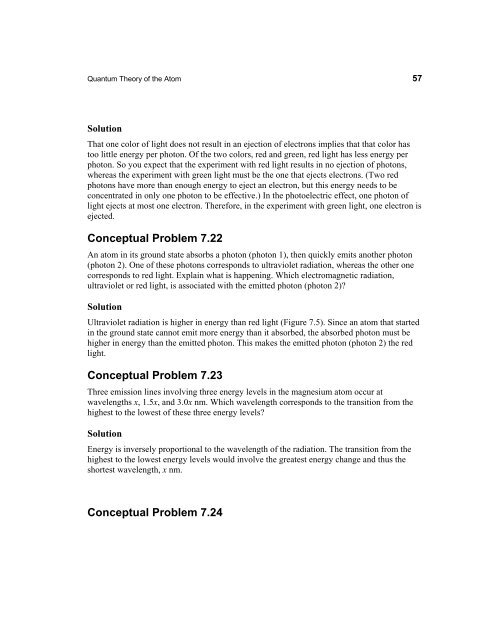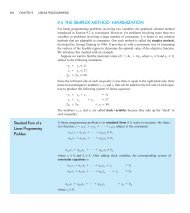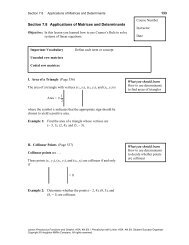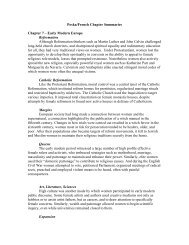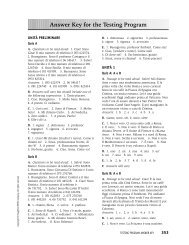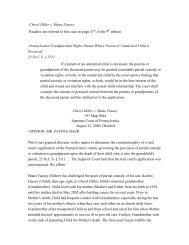Chapter 7: Quantum Theory of the Atom
Chapter 7: Quantum Theory of the Atom
Chapter 7: Quantum Theory of the Atom
You also want an ePaper? Increase the reach of your titles
YUMPU automatically turns print PDFs into web optimized ePapers that Google loves.
<strong>Quantum</strong> <strong>Theory</strong> <strong>of</strong> <strong>the</strong> <strong>Atom</strong> 57<br />
Solution<br />
That one color <strong>of</strong> light does not result in an ejection <strong>of</strong> electrons implies that that color has<br />
too little energy per photon. Of <strong>the</strong> two colors, red and green, red light has less energy per<br />
photon. So you expect that <strong>the</strong> experiment with red light results in no ejection <strong>of</strong> photons,<br />
whereas <strong>the</strong> experiment with green light must be <strong>the</strong> one that ejects electrons. (Two red<br />
photons have more than enough energy to eject an electron, but this energy needs to be<br />
concentrated in only one photon to be effective.) In <strong>the</strong> photoelectric effect, one photon <strong>of</strong><br />
light ejects at most one electron. Therefore, in <strong>the</strong> experiment with green light, one electron is<br />
ejected.<br />
Conceptual Problem 7.22<br />
An atom in its ground state absorbs a photon (photon 1), <strong>the</strong>n quickly emits ano<strong>the</strong>r photon<br />
(photon 2). One <strong>of</strong> <strong>the</strong>se photons corresponds to ultraviolet radiation, whereas <strong>the</strong> o<strong>the</strong>r one<br />
corresponds to red light. Explain what is happening. Which electromagnetic radiation,<br />
ultraviolet or red light, is associated with <strong>the</strong> emitted photon (photon 2)?<br />
Solution<br />
Ultraviolet radiation is higher in energy than red light (Figure 7.5). Since an atom that started<br />
in <strong>the</strong> ground state cannot emit more energy than it absorbed, <strong>the</strong> absorbed photon must be<br />
higher in energy than <strong>the</strong> emitted photon. This makes <strong>the</strong> emitted photon (photon 2) <strong>the</strong> red<br />
light.<br />
Conceptual Problem 7.23<br />
Three emission lines involving three energy levels in <strong>the</strong> magnesium atom occur at<br />
wavelengths x, 1.5x, and 3.0x nm. Which wavelength corresponds to <strong>the</strong> transition from <strong>the</strong><br />
highest to <strong>the</strong> lowest <strong>of</strong> <strong>the</strong>se three energy levels?<br />
Solution<br />
Energy is inversely proportional to <strong>the</strong> wavelength <strong>of</strong> <strong>the</strong> radiation. The transition from <strong>the</strong><br />
highest to <strong>the</strong> lowest energy levels would involve <strong>the</strong> greatest energy change and thus <strong>the</strong><br />
shortest wavelength, x nm.<br />
Conceptual Problem 7.24


